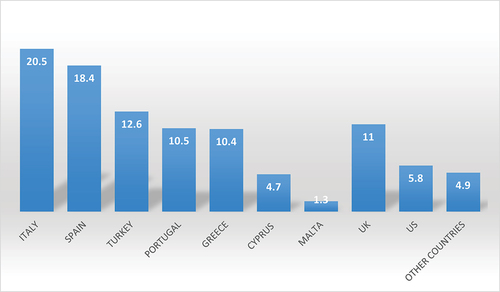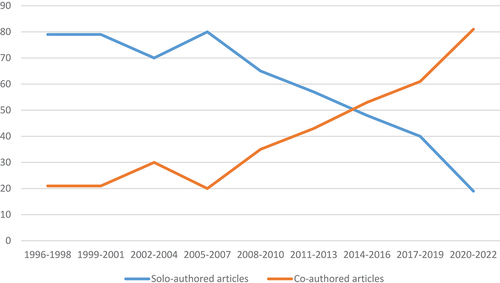ABSTRACT
This article marks a milestone in the development of South European Society and Politics (SESP) as the journal hands over to a new editorial team. Looking back over more than a quarter-century of publication, the work begins by discussing the journal’s mission and goals. Presenting new empirical data, it first takes stock of the published output, revealing the major research themes covered. Next, it investigates characteristics of authorship including gender balance, career stage, co-authorship and academic affiliation, before considering SESP’s influence on the academic community.
The current issue of South European Society and Politics (SESP) is the 99th since the journal originally commenced publication in 1996. It is also the last issue to be produced under the leadership of the current Editors. Therefore this seems an appropriate moment to take stock of the journal’s record and what it has achieved so far.
In an introductory editorial in the inaugural issue, it was declared that one of the journal’s goals was to ‘encourage work on the region’. In purely quantitative terms, the journal seems to have done just that, at least judging by the volume of its published output. To date, SESP has published a total of 679 articles. In addition, 47 review articles, covering several books on a similar theme, and 305 individual book reviews appeared, before these features were discontinued under the pressure of increasing submissions and the need to devote more space to research articles. In 2006, the journal moved from its original three issues a year to four. Although it is a regional studies publication, concerned with an area once seen as somewhat marginal to main European concerns, SESP surprised everyone – including its Editors – when it was ranked in the first quartile of the Journal Citation Reports.
Both the authors of this article have a long association with the journal. Our participation in the editorial team dates back to the 1990s and we became Editors in 1999 and 2008, respectively. In this short article, our farewell to SESP, we try to look beyond the headline numbers mentioned above. We begin by outlining what the journal set out to do, including its geographical definition of Southern Europe. Then, we take a dive into the journal’s archive in order to provide some data on what SESP has published. An examination of patterns of authorship is followed by a consideration of the journal’s impact. We conclude by thanking all those who have worked on the SESP project.
Defining the journal’s borders
Misson and strategies
South European Society and Politics was launched in 1996, two decades after the regime changes which sparked a new interest in Europe’s South and encouraged social scientists to treat it as a region with common characteristics. The mid-1990s was a particularly fertile period for the growing field of South European studies. In 1995, just one year before SESP’s first appearance, the major project on Southern Europe in Comparative Perspective, led by Richard Gunther and Nikiforos P. Diamandouros and supported by the Social Science Research Council of the United States, published the first of its five volumes. In the field of academic journals, the same year saw the birth of both The Journal of Modern Italian Studies and Modern Italy. What was missing was a journal dedicated to the study of the region as a whole and this was the gap that SESP aimed to fill.
In the introductory editorial, the members of the first editorial team, headed by founding Editors, Martin Baldwin-Edwards and Martin Rhodes, declared the journal’s aim was to provide a ‘forum’ for research on the region, including ‘comparative interdisciplinary studies of southern Europe, along with innovative country and sub-national studies’ (Baldwin-Edwards et al. Citation1996). To this end, it was planned to publish a variety of material, including research articles, briefing papers, review articles, book reviews and a ‘Research Forum’ section. The latter, which included conference reports and news on recent publications and ongoing research projects, was discontinued after 2000, as the rapid growth of electronic communication provided a better medium for this kind of information. However, its initial inclusion was indicative of the journal’s early aim to serve as an information hub and to promote closer links among scholars studying the region.
The traditional view of area studies, still quite prevalent when the journal was launched, tended to adopt an all-encompassing approach towards knowledge about a particular region and to include, for example, language, literature and culture. From the start, SESP did not position itself in this genre. It explicitly limited itself to the social sciences, excluding the humanities with the partial exception of contemporary history. The inaugural ‘Editor’s Note’ defined the disciplines to be covered as political science, sociology, social policy, social anthropology, and political economy, and clarified that both qualitative and quantitative analysis would be welcome. This initial statement of the journal’s goals remained the guiding light after the change in editorial leadership in 1999.
The keystone of SESP’s mission has thus been to deepen our understanding of Southern Europe – or rather, of its domestic politics and society, as foreign and security policy is explicitly excluded from its remit. At the same time, for a regional studies journal, it is important not to become insular or parochial. Increasingly, therefore, in its practice, SESP has aimed to contribute area-based knowledge to wider social science debates. The goal has been for its case studies to resonate beyond the specific national or regional experience and also speak to scholars without a particular interest in Southern Europe, but with an interest in the broader issues raised. This has also served the broader purpose of promoting the integration of the study of Southern Europe into the larger field of comparative European politics.
Topicality and relevance have thus been important criteria for publication in SESP. Another has been accessibility in terms of clarity and language. It has been a journal objective that articles should speak to an inclusive readership, from students to journalists, for example. SESP has also aimed to publish articles which illuminate basic aspects of South European domestic politics and which can be used by colleagues to add South European examples to their teaching syllabi.
Particularly important here are elections, the key event of political participation and weathervane of political change in any national political system. SESP has aspired to be a ‘go-to’ resource for South European election material. Specifically, a strategic decision was taken in the early 2000s to encourage the submission of articles on the significant electoral contests in the region, a policy which has been pursued consistently for the last twenty years.
A changing academic environment
For some time after the fall of the dictatorships, a certain air of exceptionalism continued to cling to Southern Europe. While it had become an interesting object of study, there was a tendency to perceive it as a region apart, in a different category from the rest of Western Europe and somewhat marginal to mainstream concerns. Then, after the wave of studies on its democratisation peaked in the 1980s and 1990s, the region rather went out of academic fashion. However, from late 2009, the eurozone crisis, triggered by the apparent imminence of a sovereign debt default in Greece, brought the Southern fringe of the European Union to the forefront of international news, refocusing academic attention on it.
The experience of Southern states under international bailouts played into broader debates about the political, social and economic impacts of harsh austerity and conditional sovereignty. The 2015–16 refugee and migrant crisis with its disruptive effects on domestic politics then kept Southern Europe in the spotlight. Meanwhile, renewed interest in Turkey was sparked by the 2013 mass mobilisations against the government and the following years of protracted democratic crisis, culminating in regime change. Today, the legacy of these critical years continues to reverberate and to reshape Southern Europe: the journal has tried to respond to the greatly increased demand for academic analyses of what has been happening.
Besides the shifting kaleidoscope of current events affecting the journal’s fields of concern, there have also been other important changes. The period of 27 years since the journal’s launch has coincided with the rapid development of the social sciences in South European universities. In the mid-1990s, political science, to give one example, was already institutionalised in Italy but elsewhere had only recently acquired autonomy from other disciplines. Since then, there has been a rapid rise in the number of university departments offering relevant degrees, as well as the emergence and impressive growth of postgraduate studies. The result has been a major expansion in the number of social scientists within the region who are potential SESP readers and authors. This period has also coincided with the growing internationalisation of academic life and particularly of academic assessment, encouraging interest in publishing in international journals. This major change in its operating environment has clearly benefited the journal and played an important part in its development.
The shape of Southern Europe
The journal’s inaugural editorial defined Southern Europe as consisting of ‘Portugal, Spain, Italy and Greece – along with smaller states such as Malta and Cyprus’ (Baldwin-Edwards et al. Citation1996, p. vii). Τhe first part of this definition reflected what by then – two decades after the parallel regime changes in Portugal, Greece and Spain – had become a widely accepted grouping, along with earlier democratiser Italy, as a distinct South European region with common characteristics. This group has sometimes been referred to as ‘core Southern Europe’ or, in more recent decades, as ‘old Southern Europe’. Meanwhile, the inclusion of the island-states of Cyprus and Malta was influenced by the fact they were already on the European Union membership trajectory which led to their accession in 2004.
In addition, the Editors suggested that southern France, ‘whilst lacking the autonomy of an independent state’, could potentially be included as well (Baldwin-Edwards et al. Citation1996, p. viii). In practice, France remained marginal to SESP. The journal’s published content includes very little French material: just five single-country case studies as well as three articles in which it was employed as a comparative case, amounting to around one per cent of the journal’s total published output. Instead, it was Turkey which emerged as a new significant country for SESP. Turkey was included as a comparative case in an article in the journal’s first issue and the first Turkish single-country study was published in 1997. But in the journal’s first five years (1996–2000), only 4.5 per cent of articles covered or included Turkey, compared to 19.5 per cent in the last five years (2018–2022).
From the early 2000s, the journal’s revised mission statement reflected this new reality. It defined SESP’s geographical scope as encompassing Italy, Greece, Portugal, Spain, Turkey, Cyprus and Malta and it is these seven South European countries which have formed the journal’s subject of study. In its coverage of the divided island of Cyprus, the journal has aimed at inclusivity. The first article on the Turkish Cypriot community appeared in 2003. In total, SESP has published 14 articles on or including developments in the northern part of Cyprus, amounting to 2.1 per cent of the journal’s total published output. Meanwhile, despite regularly receiving submissions on the Balkans, the journal has resolutely declined to expand into a regional dynamics shaped by the legacies of communism and the Yugoslav Wars.
A keyhole into the journal’s content
The presence of the South European states
We now turn to examine the comparative presence of each of these countries in the journal. shows the percentage of the journal’s total published articles which feature each of the SESP countries. What is immediately apparent is the continued predominance of ‘old Southern Europe’, with even the smaller pair of countries, Greece and Portugal, each featuring in over one-fifth of articles. Italy appears in significantly more than one-quarter, while Spain’s share approaches an impressive one-third of total articles. In the case of ‘new Southern Europe’, Turkey’s marginality during the journal’s early years may partly explain its lower score. As indicated above, the amount of material on Turkey has significantly increased over the years. Meanwhile, the share of Cyprus and Malta reflects the small size of these two countries, with their combined population of well under two million people, and of the academic communities studying them. However, the journal has actively tried to increase their visibility for example, by encouraging guest editors to include them as case studies in comparative special issues.
Figure 1. Comparative presence of the South European countries in articles published in South European Society and Politics, issues 1/1 to 28/1.
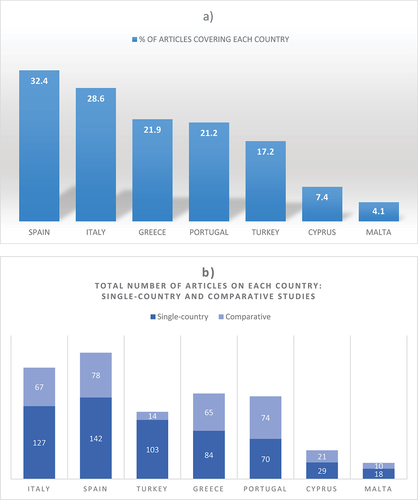
In order to gain a better sense of the role which each country plays in the journal’s published output, journal articles were then divided by type. Single-country studies account for 579 articles (85.3 per cent of the total) and comparative studies for 100 articles (14.7 per cent). shows the breakdown by country and article type, this time with absolute numbers. In the first category, the single-country studies, Spain and Italy remain the cases most frequently written about. However, here Turkey appears in third place, overtaking Greece and Portugal. In the second category, Spain and Portugal remain the most popular choices, while Malta and Turkey are the countries least likely to be included in a comparative study. In fact, the most usual country combination for comparative studies consists of the ‘old’ South European-4, amounting to around one-third of articles in this category.
While the share of comparative articles in the journal may seem small, two points should be borne in mind. First, from the early 2000s, a strategic decision was taken that South European Society and Politics should only publish intra-South European comparisons. The rationale was that broader-based comparative articles, including pan-European or cross-regional comparisons, have many potential publication outlets including multiple comparative studies journals. In contrast, the role of SESP is to provide a domain dedicated to a specific region. Second, the journal has particularly encouraged intra-regional comparative special issues, an aspect of the journal’s output to which we turn next.
Special issues
Special issues constitute an important part of the journal’s work. To date, a total of 40 have been published. Of these, 26 have been comparative volumes. This means that a significant proportion of the journal’s single-country articles have been published in the context of comparative thematic collections. The format for these is for a series of case studies addressing a particular topic in different national contexts, thus allowing direct comparisons across the region at the level of an issue rather than an individual article. presents the catalogue of these comparative special issues. As can be seen from the table, the overwhelming majority cover from four to all seven countries. A further 14 special issues have focused on single countries. The complete list can be found in .
Table 1. Comparative special issues published by South European Society and Politics, 1996–2022.
Table 2. Single-country special issues published in South European Society and Politics, 1996–2022.
To date, the journal has published four special issues each on Turkey and Spain, three on Portugal, two on Italy and one on Greece. While Cyprus and Malta have not been the subject of dedicated special issues, in the Maltese case a 4-article special section, guest edited by Michelle Cini, was published in 2002 in the run-up to the country’s EU accession.
Thematically, the special issues have covered a broad range. Characteristically, those published in the journal’s first four years addressed welfare states, immigrants and the informal economy, gender inequalities, and unemployment and its consequences. These are perennial topics whose interest is not geographically delimited. Meanwhile, examples of the journal’s concern to provide its readership with material on the most recent developments include two special issues which can be seen as ‘bookending’ its coverage of the economic crisis. The first, published in 2009, concerned the initial response during the first months after the collapse of Lehman Brothers shook the international financial system. The second, published ten years later, addressed the rollback of bailout policies after the crisis ended.
Many of the journal’s special issues have been republished by Routledge as stand-alone books in the journal’s South European Society and Politics book series, which currently numbers 31 volumes (see https://www.routledge.com/South-European-Society-and-Politics/book-series/SESP).
Major research themes
shows the major groups which emerged from a breakdown of journal articles into key themes. These groups are not collectively exhaustive, as we have only included those topics with at least 4 per cent of total articles. Nor are they mutually exclusive, as an article on a European Parliament election, for example, would be counted in both the first two groups. The picture offered in the figure is quite interesting and possibly unexpected in an area studies journal. The three main pillars of SESP’s published output, in fact, include typical political science themes referring to the representation circuit (electoral behaviour, political parties) and the link with the EU. The other themes include a broader range of social and political issues. It should also be stressed, however, that SESP has been open to a wide variety of article topics and disciplinary approaches. Articles published have included farms facing the economic crisis, Facebook and self-determination, and an anthropological study of TV cooking shows.
Figure 2. Main themes of articles published in South European Society and Politics, 1996–2022 (% of total).
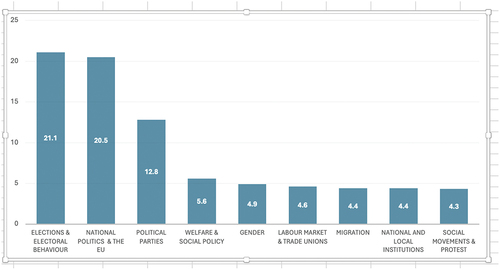
Meanwhile, the prominence of elections and electoral behaviour is explained by the journal’s strategy of trying to follow South European electoral contests. As can be seen in , the majority of important events have been included and have made SESP one of the main sources for analysis of the elections taking place in Southern Europe.Footnote1
Table 3. Elections and referendums covered in articles in South European Society and Politics, 1996–2022.
Patterns of authorship
Academic affiliation
Traditional area studies have sometimes been criticised for a tendency for ‘intellectual colonisation’, with scholars coming from outside playing an outsize role in shaping the academic view of a region. South European Society and Politics, in contrast, has overwhelmingly been written by academics from within the region. We calculated the geographical location of our authors on the basis of the academic affiliations mentioned in the bio-notes attached to published articles. Over three-quarters of authors of research articles in SESP (78.4 per cent) were based in one of our seven countries at the time of publication, compared to 21.6 per cent who were located outside Southern Europe. While in the journal’s first issue, half the articles were written by UK-based authors, in the current issue all authors work in Southern Europe. This shift reflects the role which the journal has increasingly played as a publication outlet for the growing and increasingly internationally-oriented academic community within the region itself. It should be noted though that scholars from around the world have been welcome to publish in SESP and indeed authors hail from 24 different countries.
shows the breakdown of authorship by main countries. The distribution within Southern Europe largely reflects the presence of the individual Southern countries as the subject of articles, as examined above. Italy and Spain predominate, followed by Turkey, with 51.5 per cent of authors coming from these three countries. Meanwhile, outside Southern Europe, the majority of authors come from the UK or the US.
Inclusivity
How well has the journal performed in terms of attracting a diverse base of authors? We briefly examine this question in relation to gender and career stage, topics which we have also examined in previous publications.
There has been growing interest in gender balance among authors of academic journals in recent years and this is especially important for a region like Southern Europe, where social sciences have long been male-dominated academic fields. Investigating the gender of the authors who contributed to SESP in 1996–2022, only one-third were women (34.5 per cent) versus almost two-thirds of men (65.5 per cent). Across time, the gap is extremely variable, as shown in , with the publication in some years of special issues and the focus on specific topics helping to explain the fluctuations. In the previous research, we found that this imbalance in SESP was comparable to that in many other journals and that it is explained by the lower rate of submissions by women (Verney & Bosco Citation2022).
In earlier research (Bosco et al. Citation2023) we examined the distribution of authors by academic position for the period 2010–2021. We found that authors pre-tenure track, including PhD candidates and post-doctoral scholars, were 28.6 per cent of published authors. Assistant professors, at 34.0 per cent, were a little over one-third of the total. Meanwhile, in the case of more senior scholars, associate and full professors accounted for 15.6 per cent and 21.8 per cent, respectively. This suggests that the journal has a good record in promoting junior scholars, with the two early career categories together amounting to 62.6 per cent of total authors.
The rise of collaboration
One of the big changes that emerges from an examination of the journal’s archives concerns the rise of co-authorship. Taking the period 1996–2022 as a whole, solo authorship remains a clear majority with 58.7 per cent of published articles, compared to 41.3 per cent of co-authored papers. However, this conceals a significant shift in author preferences over time. This change is illustrated by comparing SESP’s first issue in 1996, which consisted exclusively of solo-authored articles, with the current issue which is entirely made up of co-authored papers.
breaks down the split between these two types of authorship chronologically into three-year periods, making the pattern clear. For the journal’s first 12 years (1996–2007), articles by single authors were the predominant category, amounting to 70–80 per cent of the total. After that, solo authorship embarked on a continuous dive. The crossover point, when co-authored articles became the majority for the first time, occurred in the 2014 volume. In the last three-year period (2000–2022), the switchover became complete, with over 80 per cent of papers published in the journal now co-authored.
Probably, the key explanation for this impressive turnaround lies in the increasing pressure on academics to publish and the rise in quantitative indicators as a main measure of academic worth. Co-authoring allows authors to increase the number of articles they publish and to maximise citations, which are attributed to all authors of an article regardless of how many they are. SESP’s experience suggests a practice long established in the medical sciences may be becoming increasingly the norm in the social sciences too.
The journal’s academic footprint
Assessing the journal’s reception by the scholarly community can be done in two ways: measuring reader interest as reflected in downloads of articles from the journal’s website and influence on academic debate gauged through citations.
The 2000s marked the period of changeover to electronic reading. In 2004, the first full year that SESP was online, there were only 500 article downloads, as print readership remained dominant. Two years later, downloads had risen to 5,000 and by 2009, they had more than doubled again to 11,000. shows the subsequent take-off in the journal’s popularity, with over 90,000 reads annually after 2020.
Figure 6. SESP’s academic footprint: article downloads and Impact Factor scores, 2009–2022.
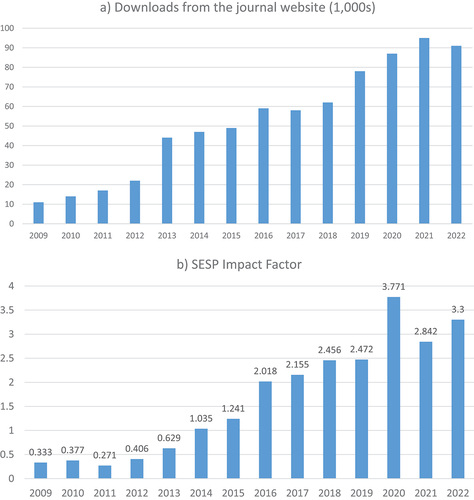
Even during the period when Southern Europe was not at the centre of academic attention, the journal was able to do pretty well. Evidence of this is that in 2008, without even applying, the journal was selected for inclusion in the Social Science Citation Index. As a consequence, since 2009 SESP has been evaluated annually by Clarivate’s Impact Factor (IF), an index based on the mean number of times articles published in the last two years receive citations in the current year.
As the IF is considered an indicator of the influence of a journal within its field, joining this club brought SESP more and better submissions, generating a virtuous circle where the latter uplifted the impact factor and vice versa. As can be seen in , the journal’s position on this index has risen almost continuously and SESP moved from the fourth (lowest) quartile in 2009 to the first in 2016, where it has remained with the exception of 2021.
Before we go
To edit a journal is a collective effort. Before saying farewell, therefore, it is important for us to thank all the people who have worked for the journal over the years. They are too many to all be mentioned individually. includes the members of the editorial team who have generously shared their time and worked hard to make this endeavour possible. Thanks are also due to all those distinguished colleagues who have taken part in the Editorial Board and supported the journal’s work. Several thousand referees are the unsung heroes whose contribution is essential for a peer review journal. We would also like to thank all those at our publishers who have worked behind the scenes to make the journal appear. Among them, we owe a special thank you to Madeleine Markey, who has managed the journal for many years. Finally, the journal would not exist without all the authors who submitted their works. Through all these people, SESP has been at the heart of the formation and expansion of a lively community, which has also found expression through the ECPR Standing Group on Southern Europe, thus uniting paper and voice.
Table 4. The members of the SESP editorial team, 1996–2023.
We are happy that the next stage in SESP’s story will take place under the leadership of its new Editors, Nicolò Conti and Bonnie Field. We could have not thought of better colleagues to lead the journal into the future. We wish them and their strong and experienced editorial team all the fulfilment that SESP can provide.
A few years ago Nicolò invited us to think about SESP’s evolution and the role the journal had acquired over time (Bosco and Verney Citation2021). His thought-provoking questions led us to appraise the road travelled. In that moment we realised that for us, editing the journal has been a ‘labour of love’, with all the frustration and satisfaction that the latter entails.
Disclosure statement
No potential conflict of interest was reported by the author(s).
Additional information
Notes on contributors
Susannah Verney
Susannah Verney is Associate Professor of European Integration and European Politics at the National and Kapodistrian University of Athens. With Anna Bosco, she is the Editor of South European Society and Politics (1999-2023) and the related Routledge book series. Her most recent book (co-edited with Anna Bosco) is The Politics of Polarisation: Conflictual Competition in Italy, Spain and Greece (Routledge, 2023).
Anna Bosco
Anna Bosco is Associate Professor of Comparative Politics and Politics of the European Union at the University of Firenze. With Susannah Verney, she has been editor of South European Society and Politics (1998-2023) and has carried out research on parties and party systems change in Spain and Southern Europe. Among her most recent publications is ‘Surviving in a male academia: gender gap, publication strategies and career stage in South European political science journals’ (in European Political Science 2023, with S. Verney, S. Bermúdez and A. Tonarelli).
Notes
1 Four collections of articles on elections in Turkey, Greece and Spain respectively can be found here: https://www.tandfonline.com/journals/fses20/collections
References
- Baldwin-Edwards, M., Rhodes, M., Verney, S., Yfantopoulos, Y. & Pridham, G. (1996) ’Editors’ note’, South European Society and Politics, vol. 1, no. 1, pp. vii–ix.
- Bosco, A. & Verney, S. (2021) ’Editing South European Society and Politics: A Labour of Love: An interview with Anna Bosco and Susannah Verney’, Italian Political Science, vol. 16, no. 1, pp. 40–45.
- Bosco, A., Verney, S., Bermúdez, S. & Tonarelli, A. (2023) ’Surviving in a male academia: gender gap, publication strategies and career stage in South European political science journals’, European Political Science. 10.1057/s41304-023-00443-8
- Verney, S. & Bosco, A. (2022) ’Unpacking the gender gap in academic journal publishing: The experience of South European Society and Politics’, European Political Science, vol. 21, no. 3, pp. 443–461.

